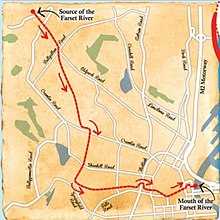River Farset
The River Farset (An Fhearsaid or Abhainn na Feirste in Irish) is a river in Belfast, Northern Ireland, which gave the city its name. It is a late tributary of the River Lagan.

Course
The Farset rises above Ballysillan on Squire's Hill, flowed past the medieval parish church at Shankill, through Millfield and under High Street, giving that street a curving appearance, entering the Lagan to the east of the Albert Clock and High Street.[1] It is on the County Antrim side of the Lagan and its entry to the Lagan is close to its outflow into Belfast Lough. The Farset is now contained within a tunnel under Belfast's High Street; a tunnel supposedly big enough to take a bus.[2]

History
Belfast was founded at a sandy ford across the Farset, and this is the origin of the city's name - Béal Feirste, the Mouth of the Farset. Farset itself comes from an Irish word meaning sandbar. Among the early references to the ford is of a battle between Ulidians and Picts in 667 and a Papal Taxation Roll of 1306 refers to 'the chapel of the Ford'. The banks of the Farset became the first quaysides of the developing merchant city and the river flowed beside docks on High Street in the 19th century.[2] In the late 18th century it was one of many Belfast rivers which provided the power for early industrialisation by powering factories and supplying water for bleach greens.[1]
In the 17th, 18th, and 19th centuries, the river was sometimes known as Belfast River, the River of Belfast, the Town River, or the High Street River.[3] Over the course of the 18th century it was gradually covered over; the final section, close to Princes Street, was covered over in 1804.[4]
See also
- List of rivers of Northern Ireland
References
- Gillespie, Raymond (2007). Early Belfast: The Origins and Growth of an Ulster Town to 1750. Ulster Historical Foundation. p. 11. ISBN 1-903688-72-8.
- "High Street at St Georges". BBC Your Place and Mine - Coast. Retrieved 28 February 2009.
- George Benn, A History of the Town of Belfast (1877), pp. 470, 527 and 548.
- George Benn, op. cit., Vol. 2, pp. 45-46.